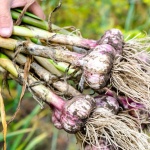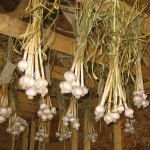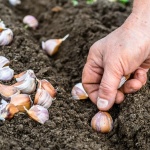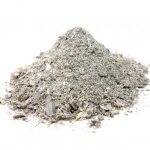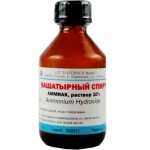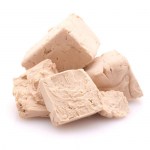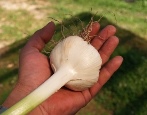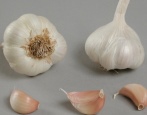
- Authors: Pivovarov V.F., Nikul'shin V.P., Khryukov V.A.
- Year of approval: 2001
- Sheet length, cm: up to 55
- Sheet width, cm: 4,2
- Leaf color: dark green with a strong waxy bloom
- The form: rounded flat
- Bulb size: large
- Bulb weight, g: 90-120
- Number of teeth: 3-5
- Clove weight, g: 2-5
Spring garlic varieties are the best choice for those who want fresh and firm garlic even in late spring. One of the most interesting is Gulliver. This variety can be attributed to winter crops, so it shoots, but even with spring planting, it does not lose productivity.
Description of the variety
Gulliver is spring garlic. Such varieties do not need to be planted before winter, they are planted in spring, and by autumn they fully ripen. Gulliver is the owner of large heads, very productive and hardy. The variety was included in the Russian Register of Breeding Achievements in 2001. It should be borne in mind: Gulliver is the only spring variety prone to shooting. Strictly speaking, it occupies an intermediate position in the range of garlic varieties. In many ways, being a winter one, it can play the role of a spring one. The originator is the Federal Scientific Center for Vegetable Growing, located in the Moscow Region.
Characteristics of the appearance of plants and bulbs
The plant is 50-70 cm high, the leaves are narrow, up to 4.2 mm, dark green, covered with a thick waxy layer.
The bulbs are large, flat-rounded, embossed. Covering scales are light gray. The mass of one head is 90-120 grams, often much larger, up to 150-250 grams. The teeth are powerful, and, which is not typical for spring varieties, they are not numerous - 3-5 pieces, according to some data their number can reach 12. But it never reaches 30, like in many spring varieties.
Purpose and taste
The taste is spicy, vigorous, very expressive. The slices are juicy. This variety is versatile and is often chosen for fresh consumption during the winter season. The variety keeps well. If you need high-quality garlic before spring, then it is better to choose spring varieties, including Gulliver. Keeping quality - up to 8 months.
Maturation
The variety belongs to the middle late, ripens 87-98 days after the emergence of mass shoots.
Yield
From 1 sq. m remove on average up to 1 kg of large heads.
Growing regions
The variety is hardy and suitable for planting in a wide variety of areas. It is officially recommended for most regions of Russia, including the Urals, Siberia, and the Far East. It grows equally well in the Leningrad region and in the North Caucasus.
Growing and caring
Spring varieties are planted in open ground in spring. The air temperature must be at least 8 ° C. Approximate landing time: April 20-25. But this period may be shifted depending on the region.
A distance of 8 cm is maintained between the teeth, 25-30 cm between the rows. The planting site should be sunny.
Watering young plantings need abundant, garlic grows intensively. By the end of May, watering is greatly reduced. In dry weather, you still need an intensive water supply, 1 bucket of water per 1 sq. m, but in a rainy summer, this procedure can be completely abandoned. In August, watering is completely stopped.
They are fed 3-4 times per season. During the period of leaf appearance, nitrogenous fertilizer is applied (just not fresh manure). At the end of June, during the formation of cloves, potassium and phosphorus are added. In the future, potassium-phosphorus fertilizers are repeated 1 more time. If wood ash is used as a source of potassium, you can water it with a weak solution once every 2 weeks.
Nutrient deficiencies are diagnosed by foliage.
The tips of the feathers dry out, although it is far from the harvesting season, slow growth - there is not enough nitrogen. Ammonium nitrate and urea are introduced.
The pale green tint of the leaves is a lack of potassium. Watered with infusion of wood ash.
The leaves turn yellow en masse (they do not dry out, but lose their green tint) - the acidity of the soil is too high.The aisles are sprinkled with dolomite flour.
Garlic is laid to dry directly on the beds, if there is no rain. Dried for 5 days, then the stems are shortened to 10 cm, and the roots up to 3 mm, sorted and placed in nets for winter storage.
The crop is harvested when the lower leaves begin to turn yellow, and the boxes on the arrows crack. Usually this is the second half of August. The cloves should already be well separated from each other, but not crumbled - this means that the bulbs are overripe.
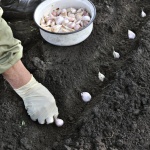
You can plant garlic twice a year. The spring species is best planted in the spring, the winter one is sown before winter. Planting time depends on the region, climatic conditions, varieties, favorable days. It is also necessary to properly prepare the planting material and beds.
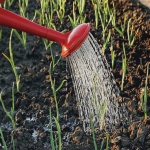
Soil requirements
The soil for garlic should be loose, airy.
Gulliver, being a spring variety, is well suited for those areas where moisture is retained in spring and winter varieties get wet. Even so, the soil must be well-drained. Prepare the soil in the fall. They dig shovels onto a bayonet, add to each square meter. m for half a bucket of compost and 1 tbsp. l. any universal fertilizer for vegetables.
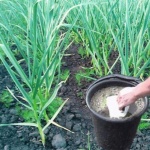
Top dressing of garlic plays a vital role in growing. The use of fertilizers contributes to the rapid growth of heads, an improvement in taste, and an increase in yield. There are many ways to feed him: this can be done with mineral or organic substances, as well as with all kinds of folk remedies.
Disease and pest resistance
Gulliver's garlic is disease resistant. Subject to agricultural technology, he practically does not get sick. The plant can be affected by standard crop pests: onion fly, hoverfly, thrips, root mites and stem nematodes. In damp, unstable summers, powdery mildew, white rot, black mold and other fungal diseases are possible. For the prevention of diseases in the spring and in the middle of summer, garlic is fed with ammonium sulfate. It is important not to allow the plantings to thicken. In summer, you can thin out the beds if the garlic is very large. Useful treatments "Fitosporin", drugs "Gamair-T", "Bitoxibacillin". Joint plantings with calendula or chicory are useful, they protect against stem nematode, the most dangerous pest of garlic.
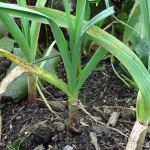
Review overview
There are few reviews, but they are all positive. The variety is amazing and shocking. The heads are weighty, with huge protruding teeth. And also pleases with its unique combination of qualities: this variety will provide a harvest even for those gardeners who did not plant garlic last fall. Others can plant it in the fall, it winters well, unlike other spring varieties. Gardeners like a really bright taste and a powerful brutal shape (heads are called square). And also Gulliver is completely unpretentious, adapts well to the conditions of a particular site. Does not require special care, is not affected by pests. With a minimum of care, the harvest is good, many heads are larger than the official size. A strong variety in all respects.
